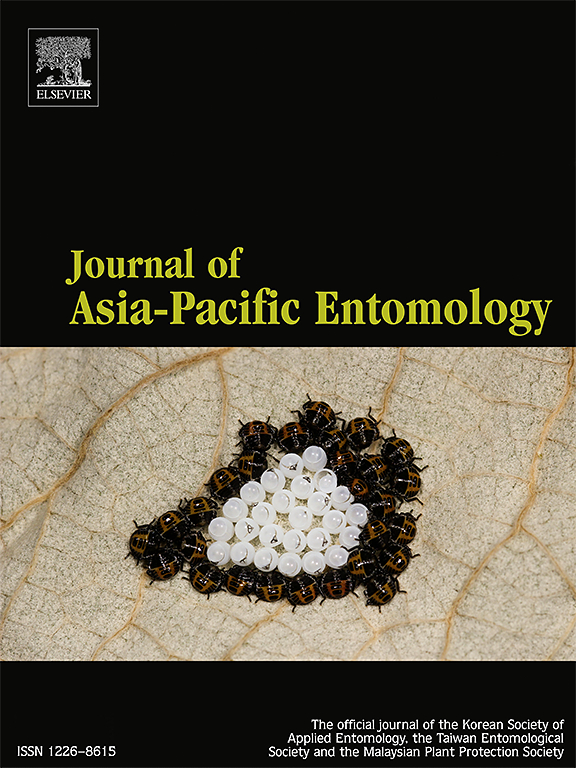A deep learning-based method for silkworm egg counting
IF 1.1
3区 农林科学
Q3 ENTOMOLOGY
引用次数: 0
Abstract
The counting of silkworm eggs is an essential task in the selection and breeding of new silkworm species, as well as in silkworm egg production. Currently, this task mainly relies on manual counting, which poses many challenges such as high workload, low efficiency, and being error-prone. To alleviate these problems, this study proposes a deep learning-based method for silkworm egg counting. Images of silkworm eggs were captured from actual environments and annotated using a labeling tool, resulting in more than 300,000 labeled eggs. A counting network based on the You Only Look Once (YOLOv8n) object detection network is proposed, in which an efficient multi-scale attention (EMA) module is embedded in the extraction block of the original network to enhance feature representation capability and suppress interference. To further improve counting performance, a space-to-depth convolution (SPD-Conv) block is introduced to replace the down-sample layer implemented by convolutional layers with a stride of 2. The proposed network is termed YOLO for silkworm egg counting (YOLO-SEC). Experimental results demonstrate that our YOLO-SEC achieves a recall of 99.50 %, a precision of 98.29 %, an F1-score of 0.99, and an AP of 99.31 % for silkworm eggs on the test set. Meanwhile, YOLO-SEC shows significant performance advantages over the original YOLOv8 (n ∼ x), state-of-the-art networks (YOLOv7-tiny, YOLOv9s, YOLOv10n and YOLOv11n), and related networks (YOLOv8-QR, EDGC-YOLO, Faster-YOLO-AP, YOLOv8-ECFS). This research provides technical support for the breeding and egg production process of silkworms.

一种基于深度学习的蚕卵计数方法
蚕卵计数是蚕种选育和蚕种生产的重要环节。目前,该任务主要依靠人工计数,存在工作量大、效率低、易出错等问题。为了解决这些问题,本研究提出了一种基于深度学习的蚕卵计数方法。从实际环境中捕获蚕卵的图像,并使用标记工具进行注释,产生了30多万个标记卵。提出了一种基于YOLOv8n (You Only Look Once)目标检测网络的计数网络,在原网络的提取块中嵌入高效的多尺度注意(EMA)模块,增强特征表示能力,抑制干扰。为了进一步提高计数性能,引入了一个空间到深度卷积(SPD-Conv)块来取代由步长为2的卷积层实现的下采样层。提出的网络被称为YOLO蚕卵计数(YOLO- sec)。实验结果表明,该方法对蚕卵的召回率为99.50%,准确率为98.29%,f1分数为0.99,AP为99.31%。同时,与原始的YOLOv8 (n ~ x)、最先进的网络(YOLOv7-tiny、YOLOv9s、YOLOv10n和YOLOv11n)以及相关网络(YOLOv8- qr、EDGC-YOLO、faster - yoloo - ap、YOLOv8- ecfs)相比,yolov - sec表现出显著的性能优势。本研究为桑蚕的育种和产卵过程提供了技术支持。
本文章由计算机程序翻译,如有差异,请以英文原文为准。
求助全文
约1分钟内获得全文
求助全文
来源期刊

Journal of Asia-pacific Entomology
Agricultural and Biological Sciences-Insect Science
CiteScore
2.70
自引率
6.70%
发文量
152
审稿时长
69 days
期刊介绍:
The journal publishes original research papers, review articles and short communications in the basic and applied area concerning insects, mites or other arthropods and nematodes of economic importance in agriculture, forestry, industry, human and animal health, and natural resource and environment management, and is the official journal of the Korean Society of Applied Entomology and the Taiwan Entomological Society.
 求助内容:
求助内容: 应助结果提醒方式:
应助结果提醒方式:


